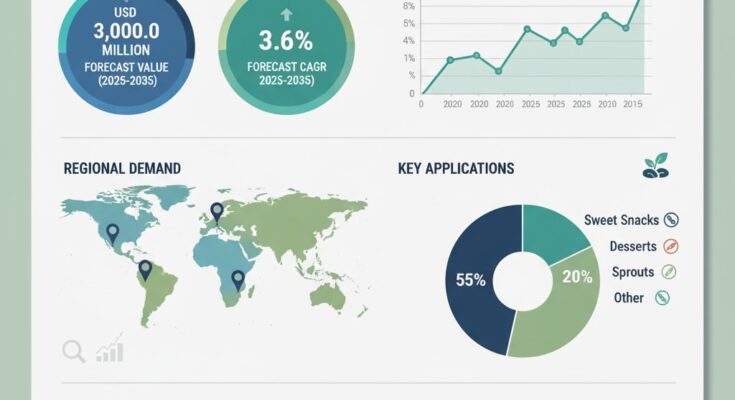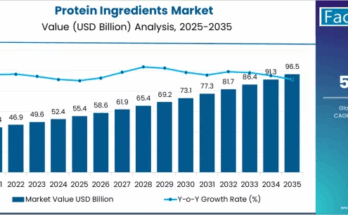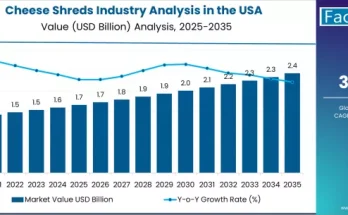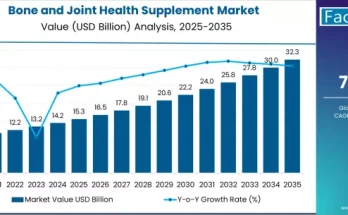The global adzuki beans market is poised for steady expansion, supported by increasing consumer demand for high-protein, low-fat plant-based foods and the growing popularity of traditional Asian ingredients worldwide. Valued at USD 2,100.0 million in 2025, the market is projected to reach USD 3,000.0 million by 2035, recording an absolute increase of USD 900.0 million over the forecast period. This reflects a compound annual growth rate (CAGR) of 3.6% between 2025 and 2035.
As dietary preferences shift toward sustainable and functional food options, adzuki beans—known for their rich nutritional profile, including protein, fiber, and antioxidants—are emerging as a preferred choice among health-conscious consumers. Their versatile use in soups, desserts, snacks, and plant-based meat alternatives continues to expand across regions, especially in Asia-Pacific and North America.
Market Drivers: Plant-Based Nutrition, Functional Ingredients, and Sustainable Agriculture
Rising Consumer Interest in Plant-Based Proteins
The global trend toward plant-based diets is fueling the adoption of legumes like adzuki beans as a sustainable protein source. They are gaining traction not only in traditional Asian cuisines but also in Western markets, where food manufacturers are incorporating them into energy bars, baked goods, and protein-rich snacks. Their high nutrient density and low environmental footprint align with the growing movement toward eco-friendly and ethical food production.
Health Benefits and Functional Food Applications
Adzuki beans are celebrated for their numerous health benefits, including improved digestion, weight management, and blood sugar regulation. Their antioxidant and mineral content makes them ideal for functional foods and nutraceutical formulations. The increasing number of consumers seeking natural remedies for lifestyle-related diseases such as diabetes and obesity further boosts market demand.
Sustainability and Organic Cultivation Trends
The push toward organic farming and non-GMO crops has significantly influenced adzuki bean production. Sustainable cultivation practices, coupled with government incentives for legume farming, are encouraging farmers to adopt adzuki beans as a rotational crop. These trends are particularly strong in Japan, China, and India, where government initiatives are promoting legume self-sufficiency and soil fertility enhancement.
Competitive Landscape
The adzuki beans market is moderately fragmented, with global and regional players focusing on improving product quality, expanding processing capabilities, and enhancing distribution networks. Companies are also investing in product innovation to cater to evolving consumer preferences for convenience and health-focused foods.
Key Players in the Adzuki Beans Market:
- Hokkaido Adzuki Co
- Maruyama Beans
- Shizuoka Agri
- Nisshin Foods
- Wismettac
- Sunrich
- ADM
- Batory Foods
- Ingredion
- Morinaga
- Sapporo Holdings
- Oisix
- Pulmuone
- Ardent Mills
- Kikkoman
These companies are leveraging strategic partnerships, sourcing initiatives, and technology integration to improve supply chain efficiency and ensure consistent product quality. Expanding into high-growth regions such as North America and Europe remains a key focus for international players.
Recent Developments
- August 2025 – Japan’s Ministry of Agriculture announced new subsidies for sustainable adzuki bean cultivation to promote eco-friendly legume farming.
- May 2024 – ADM and Morinaga collaborated to develop high-protein snack formulations using adzuki bean flour to target the growing plant-based protein market.
- January 2024 – Batory Foods expanded its distribution network in North America to meet the increasing demand for Asian-origin ingredients, including adzuki beans.
Segmentation of the Adzuki Beans Market
The global market is segmented based on form, nature, end use, distribution channel, and region, reflecting the diversity in applications and consumer preferences.
- By Form: Whole, Powdered, and Paste
- By Nature: Conventional and Organic
- By End Use: Food & Beverages, Nutraceuticals, Animal Feed, and Others
- By Distribution Channel: Supermarkets/Hypermarkets, Specialty Stores, Online Retailers, and Direct Sales
Regionally, the market spans North America, Latin America, Europe, East Asia, South Asia & Pacific, and the Middle East & Africa.
- East Asia—led by Japan and China—remains the largest consumer and producer, owing to deep-rooted culinary traditions and local processing industries.
- North America is witnessing rapid growth as food manufacturers introduce adzuki-based snacks and bakery items.
- Europe shows increasing potential with the rise of vegan and health-oriented diets.
Future Outlook: Expanding Global Presence and Functional Innovations
Over the next decade, the adzuki beans market is set to experience diversification across product categories and regions. Major trends shaping the market’s future include:
- Expansion in Functional Food and Beverage Applications – Growing use of adzuki beans in protein powders, energy drinks, and plant-based dairy alternatives.
- Innovation in Processing Technologies – Improved milling and roasting techniques to enhance flavor, texture, and nutritional retention.
- Global Trade Expansion – Increased exports from Asia to North America and Europe driven by higher consumer awareness.
- Focus on Organic and Clean-Label Products – Rising demand for traceable, sustainably sourced adzuki beans.
By 2035, the adzuki beans market will evolve into a globally recognized segment of the plant-protein industry, bridging traditional food cultures and modern nutrition trends.



